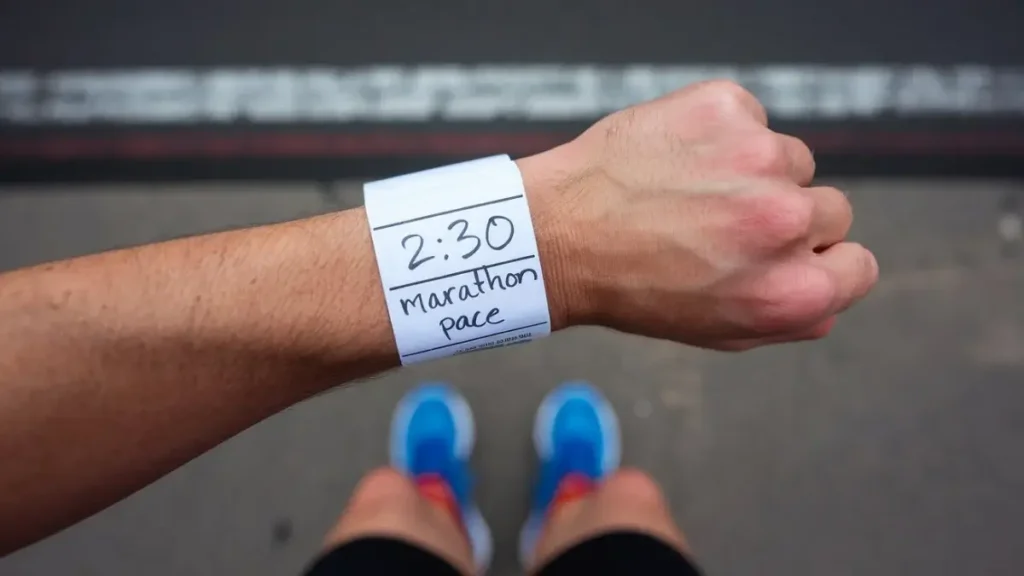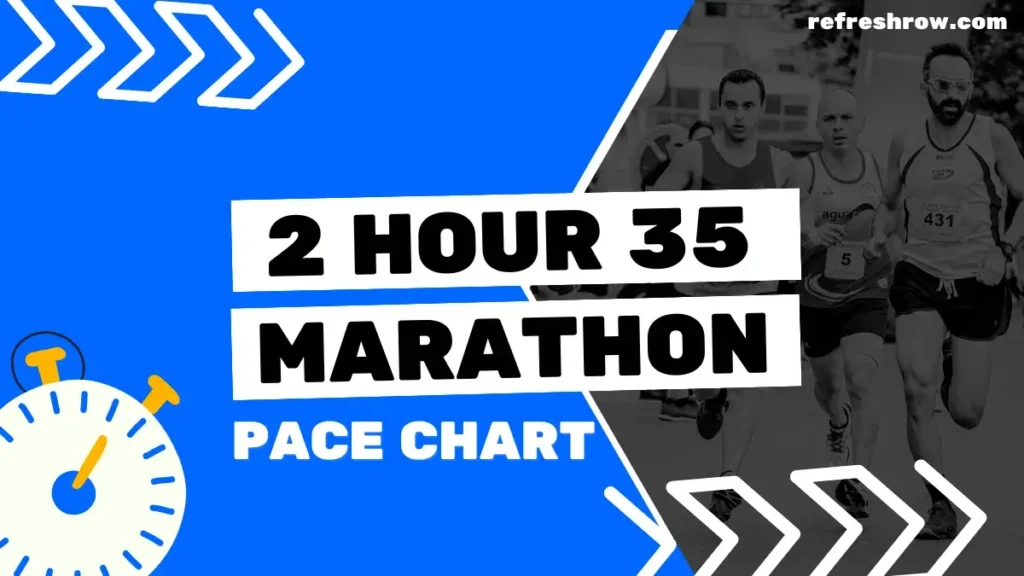To run a 3:45 hour marathon you need to run at a pace of 8:35 per mile or 5:20 per kilometer.
Following the splits below (and shaving off a second), you’ll run a sub 3:45 marathon.
I’d recommend aiming to run 1-2 minutes ahead of the split target time from 10 miles, as you’ll likely come up against crowding on race day.
3:45 Marathon Pace in Miles
| Mile | Split |
|---|---|
| 1 | 8:35 |
| 2 | 17:10 |
| 3 | 25:45 |
| 4 | 34:20 |
| 5 | 42:54 |
| 6 | 51:29 |
| 7 | 1:00:04 |
| 8 | 1:08:39 |
| 9 | 1:17:14 |
| 10 | 1:25:49 |
| 11 | 1:34:24 |
| 12 | 1:42:59 |
| 13 | 1:51:34 |
| 14 | 2:00:09 |
| 15 | 2:08:43 |
| 16 | 2:17:18 |
| 17 | 2:25:53 |
| 18 | 2:34:28 |
| 19 | 2:43:03 |
| 20 | 2:51:38 |
| 21 | 3:00:13 |
| 22 | 3:08:48 |
| 23 | 3:17:23 |
| 24 | 3:25:58 |
| 25 | 3:34:32 |
| 26 | 3:43:07 |
| 26.2 | 3:45:00 |
3:45 Marathon Pace in KM
| KM | Split |
|---|---|
| 1 | 5:20 |
| 2 | 10:40 |
| 3 | 16:00 |
| 4 | 21:20 |
| 5 | 26:40 |
| 6 | 32:00 |
| 7 | 37:20 |
| 8 | 42:40 |
| 9 | 47:59 |
| 10 | 53:19 |
| 11 | 58:39 |
| 12 | 1:03:59 |
| 13 | 1:09:19 |
| 14 | 1:14:39 |
| 15 | 1:19:59 |
| 16 | 1:25:19 |
| 17 | 1:30:39 |
| 18 | 1:35:59 |
| 19 | 1:41:19 |
| 20 | 1:46:39 |
| 21 | 1:51:59 |
| 22 | 1:57:19 |
| 23 | 2:02:39 |
| 24 | 2:07:59 |
| 25 | 2:13:19 |
| 26 | 2:18:39 |
| 27 | 2:23:58 |
| 28 | 2:29:18 |
| 29 | 2:34:38 |
| 30 | 2:39:58 |
| 31 | 2:45:18 |
| 32 | 2:50:38 |
| 33 | 2:55:58 |
| 34 | 3:01:18 |
| 35 | 3:06:38 |
| 36 | 3:11:58 |
| 37 | 3:17:18 |
| 38 | 3:22:38 |
| 39 | 3:27:58 |
| 40 | 3:33:18 |
| 41 | 3:38:38 |
| 42 | 3:43:58 |
| 42.2 | 3:45:00 |
Other Marathon Pace Charts
Targeting a different time?
Check out the Full Marathon Pace Chart in Miles or KM
Or select a specific finishing time below:
| 3:00 | 4:00 | 5:00 | |
| 3:05 | 4:05 | 5:15 | |
| 3:10 | 4:10 | 5:30 | |
| 3:15 | 4:15 | 5:45 | |
| 3:20 | 4:20 | 6:00 | |
| 3:25 | 4:25 | 6:15 | |
| 2:30 | 3:30 | 4:30 | 6:30 |
| 2:35 | 3:35 | 4:35 | 6:45 |
| 2:40 | 3:40 | 4:40 | 7:00 |
| 2:45 | 3:45 | 4:45 | |
| 2:50 | 3:50 | 4:50 | |
| 2:55 | 3:55 | 4:55 |
Training for a 3:45 Marathon
Is 3:45 a Good Marathon Time?
Well, what do the stats say?
Run Repeat conducted a study that contains 19,614,975 marathon results from more than 32,335 races across the globe, here is how a 3:45 marathon compares against age and gender for the races recorded:
| Overall | You’re faster than 83.2% of all runners. |
| Male | You’re faster than 76.6% of males. |
| Female | You’re faster than 92.0% of females. |
| <20 | You’re faster than 79.3% of under 20s. |
| 20-29 | You’re faster than 78.4% of 20-29 year olds. |
| 30-39 | You’re faster than 78.9% of 30-39 year olds. |
| 40-49 | You’re faster than 82.7% of 40-49 year olds. |
| 50-59 | You’re faster than 89.8% of 50-59 year olds. |
| >60 | You’re faster than 96.8% of over 60s. |
Training Runs and Paces for a 3:45 Marathon
To break a 3:45 marathon you’ll need to do some serious distance in your training, I recommend at least 35 miles (56km) per week.
You’re also going to need to make sure you’ve crossed off these milestones for other race distances:
- A 5k in 23:30 mins
- A 10k in 48:50 mins
- A half marathon in 1 hour 41 mins
Training Paces
| Pace | Mins per Mile | Mins per KM |
|---|---|---|
| Easy | 9:40 | 6:00 |
| Steady | 8:35 | 5:19 |
| 10k | 7:52 | 4:53 |
| 5k | 7:33 | 4:41 |
| 1 Mile | 7:00 | 4:22 |
Weekly Mileage Targets
| Target Mileage: | Gradually increase your weekly mileage from 35 miles (56 km) to a peak of 60 miles (97 km). |
| Incremental Increase: | Increase mileage by approximately 10% each week, with every fourth week as a recovery week where mileage is reduced by 20-30%. Make sure to taper for the last 1-2 weeks. |
Long Run Structure
| Total Distance: | Build up to long runs of 20-22 miles (32-35 km). |
| Segment Example: | First 5 miles (8 km): Easy pace, heart rate 140-150 bpm (approximately 10:00/mile or 6:12/km). Next 1 mile (1.6 km): Fast pace at 7:20/mile (4:34/km). Next 5 miles (8 km): Medium effort, heart rate around 160 bpm (approximately 8:20/mile or 5:11/km). Repeat: Repeat the segment twice (5 miles easy, 1 mile fast, 5 miles medium), you can taper the final 2 miles if required. |
Why This Works: Incorporating varied paces within long runs enhances lactate tolerance, which helps on race day when you’ve got to maintain pace despite feeling fatigued. By practicing surges during a run, you can build up your physical and mental resilience (lots of elite marathon runners use these strategies during their training)
Alternating Long Runs: Alternate between structured long runs (easy/fast segments) and easier long runs. For easier long runs, maintain a steady, comfortable pace throughout, focusing on mileage rather than speed to aid recovery.
Speedwork Sessions
| Short Intervals: | – 800m repeats at 3:40 per interval (4:34/km). – Aim for 6-12 repetitions with equal time for recovery. |
| Mile Repeats: | – 1 mile repeats at 7:20 per mile (4:34/km). – Aim for 6-12 repetitions with a 1-2 minute recovery jog. |
| Longer Intervals: | – 2 mile repeats at 7:30 per mile (4:40/km). – Aim for 5-8 repetitions with a 2-3 minute recovery jog. |
Recovery and Rest Days
| Rest Days: | You don’t need to incorporate rest days if you are using recovery runs, but I recommend taking 1 (or a max of 2) per week to allow your body to recover and prevent overtraining. |
| Easy Run Days: | Include 1-2 easy run days per week at a relaxed pace of 10:15/mile (6:22/km), covering 5-10 miles (8-16 km) per day. Try to keep your heart rate below 140 bpm on easy days to ensure proper recovery and aerobic development. |
My Tips to Run a Sub 3:45 Marathon
Listen to Your Body
One of the most valuable lessons I’ve ever learned for training is to listen to your body.
It’s easy to get caught up in hitting every training milestone, but it’s crucial to pay attention to how your body feels.
If you’re feeling unusually fatigued, experiencing persistent pain, or just not feeling right, take a step back.
I did have times when pushing through discomfort led to minor injuries that could have been avoided with a bit of rest.
Trust your body’s signals and don’t hesitate to adjust your training plan when needed.
Embrace the Tapering Period
One of the most surprising tips I can offer from my journey is to fully embrace the tapering period.
In the final two to three weeks before your race, gradually reduce your mileage.
I know it feels counterintuitive to run less right before the big day, but tapering helps your muscles recover and build strength.
During my tapering phase, I focused on quality over quantity, fine-tuning my pace, and ensuring I was well-rested.
TRUST THE PROCESS – those reduced miles will pay off when you hit the start line feeling fresh and ready to smash your goals.
Invest in Quality Gear
Don’t underestimate the impact of good quality gear on your training and race performance.
Investing in the right pair of running shoes, moisture-wicking clothing, and proper accessories like a supportive running belt or hydration system can make a huge difference.
I found that a comfortable, well-fitted pair of shoes not only prevented things like rubbing and blisters but also massively helped out with my recovery, helping me to hit a weekly target distance more easily.
Similarly, technical clothing that managed sweat kept me comfortable on long runs, and stopped every runner’s worst nightmare – chafe.
Find gear that works best for you by going down to the shop and having a play – it’s worth the time and cash investment.
Track Your Progress and Celebrate Milestones
Keeping track of your progress can be incredibly motivating.
Use a running app or a journal to log your runs, noting distance, pace, and how you felt.
(cough…add me on Strava…cough)
Reviewing your progress over time can provide valuable insights into your training and highlight how far you’ve come.
Additionally, celebrate your milestones, whether it’s a new personal best for a 10K or completing a particularly tough long run.
Celebrating these small victories kept my spirits high and my motivation strong.
Remember, the journey to a 3:45 marathon is made up of many small steps, each one building you up til you hit it and cross the finish line.


Row Brown is the founder of Refresh Row. He is a keen marathon runner, his favorite being the London Marathon. He’s now set himself the mission of Running the Entire Length of Spain, which is scheduled for late 2024.


